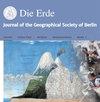How did Swiss forest trees respond to the hot summer 2015
IF 0.6
4区 地球科学
Q3 GEOGRAPHY
引用次数: 10
Abstract
Central Europe experienced an exceptionally hot summer in 2015. The area of investigation in the Central Alps in Switzerland faced the second warmest summer since the beginning of measurements in 1864. As a consequence, agriculture suffered from considerable production losses. But how were forests affected by the hot summer? We analyzed stem growth data, measured by automated point dendrometers, from 50 trees across nine sites covering the four main Swiss tree species spruce (Picea abies), fir (Abies alba), beech (Fagus sylvatica) and oak (Quercus spp.) in the years 2014 (relatively wet and cool) and 2015 (hot and dry). Annual growth and environmental conditions were determined by, and related to, the growing period based on daily resolved growth data. Our multi-species approach revealed a wide range of responses. Radial growth of spruce was largely reduced during the hot summer 2015 for sites located below 1500 m a.s.l.. Growth of beech responded even positively at several sites on the Swiss Plateau. Fir and oak did not significantly deviate from their respective average growth rate. We conclude that one hot summer actually matters for stem growth, but its effect is not a priori negative. The timing of the heat wave is of highest importance. A relatively wet previous year, a wet spring and the relatively late occurrence of the heat wave in the wood growth period led to a less strong growth reduction than what could have been expected from agricultural plants. Endogenous effects like mast fruiting and legacy effects from past conditions are suggested to further play an important role for stem growth. Zusammenfassung Mitteleuropa erlebte einen außergewöhnlich heißen Sommer im Jahr 2015. Das Untersuchungsgebiet über verschiedene Höhenstufen in den Zentralalpen der Schweiz verzeichnete den zweitwärmsten Sommer seit Beginn der Messungen im Jahr 1864. In der Folge erlitt die Landwirtschaft erhebliche Produktionsverluste. Aber wie wirkte sich der heiße Sommer auf die Wälder aus? Wir analysierten Stammwachstumsdaten der Jahre 2014 (relativ nass und kühl) und 2015 (heiß und trocken), gemessen mit automatischen Punktdendrometern an 50 Bäumen der vier wichtigsten Schweizer Baumarten Fichte (Picea abies), Tanne (Abies alba), Buche (Fagus sylvatica) und Eiche (Quercus spp.) an neun Standorten. Das Stammwachstum wurde anhand der täglich aufgelösten Daten Vol. 150, No. 4 · Research article D I E E R D E Journal of the Geographical Society of Berlin DOI:10.12854/erde-2019-420 Susanne Burri, Elena Haeler, Werner Eugster, Matthias Haeni, Sophia Etzold, Lorenz Walthert, Sabine Braun, Roman Zweifel 2019: How did Swiss forest trees respond to the hot summer 2015? – DIE ERDE 150 (4): 214-229瑞士的森林树木如何应对2015年炎热的夏天
2015年,中欧经历了一个异常炎热的夏天。瑞士阿尔卑斯中部的调查地区面临着自1864年开始测量以来第二个最温暖的夏天。因此,农业遭受了相当大的生产损失。但是炎热的夏天对森林有什么影响呢?我们分析了2014年(相对潮湿和凉爽)和2015年(炎热和干燥)9个地点50棵树的茎生长数据,这些数据由自动点树木计测量,涵盖了瑞士四种主要树种云杉(Picea abies)、冷杉(abies alba)、山毛榉(Fagus sylvatica)和橡树(Quercus spp.)。年生长量和环境条件由生长期决定,并与生长期相关。我们的多物种方法揭示了广泛的反应。在2015年炎热的夏季,海拔1500米以下的云杉径向生长明显减少。在瑞士高原的几个地点,山毛榉的生长甚至有积极的反应。冷杉和栎树的生长速率与平均生长速率没有明显的差异。我们的结论是,一个炎热的夏天实际上对茎的生长有影响,但它的影响不是先验的负面影响。热浪的时间是最重要的。相对潮湿的前一年,潮湿的春季和在木材生长期相对较晚出现的热浪导致了较弱的生长减少,而不是对农业植物的预期。内源效应如杆实效应和过去条件的遗留效应进一步对茎的生长起重要作用。Zusammenfassung Mitteleuropa erlebte einen außergewöhnlich he ßen Sommer in Jahr 2015。Das Untersuchungsgebiet verschiedene Höhenstufen in den Zentralalpen der Schweiz verzeicnete den zweitwärmsten Sommer seit Beginn der Messungen in Jahr 1864。In der Folge erlitt die Landwirtschaft erheblichproductionsverluste。阿伯尔,我在这里工作过吗?与2014年(相对质量和质量)和2015年(相对质量和质量)、2015年(相对质量和质量)、2015年(相对质量和质量)、2015年(相对质量和质量)、2015年(相对质量和质量)、2015年(相对质量和质量)、2015年(相对质量和质量)、2015年(相对质量和质量)、2015年(相对质量和质量)、2015年(相对质量和质量)、2015年(相对质量和质量)、2015年(相对质量和质量)、2015年(相对质量和质量)、2015年(相对质量和质量)、2015年(相对质量和质量)、2015年(相对质量和质量)、2015年(相对质量和质量)、2015年(相对质量和质量)、2015年(相对质量和质量)、2015年(相对质量和质量)、2015年(相对质量和质量)、2015年(相对质量和质量)、2015年(相对质量和质量)、2015年(相对质量和质量)、2015年)、2015年(相对质量和质量)。Das Stammwachstum wurde anhand der täglich aufgelösten Daten Vol. 150, No. 4·研究文章D I E E R D E柏林地理学会学报DOI:10.12854/erde-2019-420 Susanne Burri, Elena Haeler, Werner Eugster, Matthias Haeni, Sophia Etzold, Lorenz Walthert, Sabine Braun, Roman Zweifel 2019:瑞士森林树木如何应对2015年炎热的夏天?- die erde 150 (4): 214-229
本文章由计算机程序翻译,如有差异,请以英文原文为准。
求助全文
约1分钟内获得全文
求助全文
来源期刊

Erde
GEOGRAPHY, PHYSICAL-GEOSCIENCES, MULTIDISCIPLINARY
CiteScore
2.90
自引率
6.20%
发文量
0
审稿时长
>12 weeks
期刊介绍:
DIE ERDE is a publication of the Geographical Society of Berlin
DIE ERDE is a scientific journal in Geography, with four issues per year with about 100 pages each. It covers all aspects of geographical research, focusing on both earth system studies and regional contributions.
DIE ERDE invites contributions from any subfield of both Physical and Human Geography as well as from neighbouring disciplines.
 求助内容:
求助内容: 应助结果提醒方式:
应助结果提醒方式:


